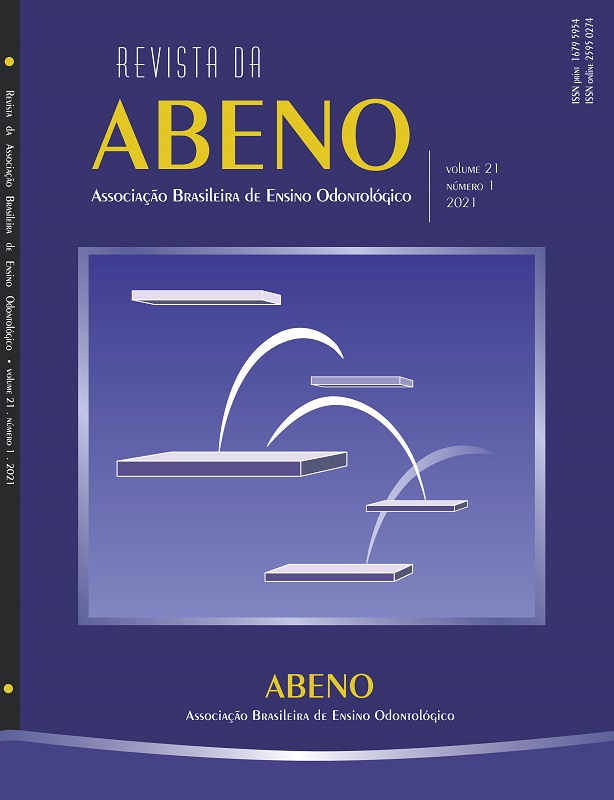Profile of endodontists in a Brazilian metropolis regarding dental care for patients with special needs
DOI:
https://doi.org/10.30979/rev.abeno.v21i1.1157Keywords:
Education, Dental, Graduate. Dental Care for Disabled. Health Services Accessibility. Endodontics.Abstract
The aim of this study was to characterize the profile of endodontic professionals from the state of São Paulo, Brazil in relation to dental treatment for patients with special needs (PSN). An online questionnaire on professional training and data on PSN dental care was sent to 3,500 endodontic professionals registered with the São Paulo Regional Dental Council in 2017. Of the 138 returning professionals, 57.2% were female; 34.8% aged 31-40 years; 42.8% had 11-20 years since graduation; 38.4% had 11-20 years of endodontic specialization. Only 22.5% were trained to provide dental care to PSNs and of these, 58.1% had only theoretical classes. Of those who did not receive post-graduation training, 80.4% would like to have received it. Regarding the interest in PSN care courses after specialization, it was observed that only 15.9% performed some type of course, most of them theoretical only. Regarding difficulties during PSN care, "lack of patient collaboration during care" was mentioned by 74.6%, and "insecurity due to lack of professional preparation" by 55.0%. The analysis of the association of variables by the Chi-square test showed that the longer the training time, the lower the difficulty during PSN care (p=0.0415). Specialists find more difficulties compared to those with associated training (masters and doctorate) (p=0.0369). There was no significant association between difficulties in PSN care and type of HEI (public or private) (p> 0.05). The current panorama of endodontic professional training does not seem to include care for patients with special needs.Downloads
References
(1) World Health Organization. World report on disability. 2012. [Acesso em: 02/06/2019]. Disponível em: http://www.pessoacom deficiencia.sp.gov.br/usr/share/documents/RELATORIO_MUNDIAL_COMPLETO.pdf.
(2) Instituto Brasileiro de Geografia e Estatística. Pessoas com deficiência no estado de São Paulo censo demográfico - 2010. Rio de Janeiro: Instituto Brasileiro de Geografia e Estatística; 2010. [Acesso em: 02/06/2019]. Disponível em: http://www.pessoacomdefi ciencia.sp.gov.br/Content/uploads/20131213114958_2013analise_censo_EstSP.pdf.
(3) Ministério da Saúde. Saúde Bucal. Caderno de Atenção Básica, n° 17. 2008. [Acesso em: 02/06/2019]. Disponível em: http://bvsms. saude.gov.br/bvs/publicacoes/saude_bucal.pdf.
(4) Conselho Federal de Odontologia. Resolução CFO-25/2002, 16 de maio de 2002. Estabelece as áreas de competência para atuação dos especialistas em Disfunção Têmporo-Mandibular e Dor Orofacial; Odontogeriatria; Odontologia do Trabalho; Odontologia para Pacientes com Necessidades Especiais e em Ortopedia Funcional dos Maxilares e dá outras providências. Diário Oficial da União 2002; maio 28.
(5) Krause M, Vainio L, Zwetchkenbaum S, Inglehart MR. Dental Education About Patients with Special Needs: A Survey of U.S. and Canadian Dental Schools. J Dent Educ. 2010;74(11):1179-89.
(6) Ahmad MS, Razak IA, Borromeo GL. Special Needs Dentistry: perception, attitudes and educational experience of Malaysian dental students. Eur J Dental Educ. 2015;19:44-52.
(7) Dougall A, Pani SC, Thompson S, Faulks D, Romer M, Nunn J. Developing an undergraduate curriculum in Special Care Dentistry – by consensus. Eur J Dent Educ. 2017;7:46-56.
(8) Bonato LL, Lopes AMS, Silva CM, Itner RG, Silva ACH. Situação atual da formação para assistência de pessoas com necessidades especiais nas faculdades de odontologia no Brasil. ClipeOdonto. 2013;5(1):10-5.
(9) Thikkurissy S, Lal S. Oral Health Burden in Children with Systemic Diseases. Dent Clin North Am. 2009;53(2):351-7.
(10) Sinha N, Singh B, Chhabra KG, Patil S. Comparison of oral health status between children with cerebral palsy and normal children in India: A case–control study. J Indian Soc Periodontol. 2015;19(1):78-82.
(11) Al-Batayneh OB, Owais AI, Al-Saydali MO, Waldman HB. Traumatic dental injuries in children with special health care needs. Dental Traumatol. 2017;33(4):269–75.
(12) Conselho Federal de Odontologia. Quantidade geral de profissionais e entidades ativas. 2019. [Acesso em: 02/06/2019]. Disponível em: http://cfo.org.br/website /estatisticas/quantidade-geral-de-entidades-e-profissionais-ativos/.
(13) Conselho Regional de Odontologia de São Paulo. Especialidades. [Acesso em: 02/06/2019]. Disponível em: http://www.crosp.org.br/intranet/estatisticas/estEspecialistas.php.
(14) Yap E, Parashos P, Borromeo GL. Root canal treatment and special needs patients. Int Endod J. 2014;48(4):351–61.
(15) Leal Rocha LL, Saintrain MVL, Vieira-Meyer APGF. Access to dental public services by disabled Persons. BMC Oral Health. 2015;15:35.
(16) Williams JJ, Spangler CC, Yusaf NK. Barriers to dental care access for patients with special needs in an affluent metropolitan community. Spec Care Dentist. 2015;35(4):190-96.
(17) Ministério de Educação e Cultura (MEC). Cadastro Nacional de Cursos e Instituições de Educação Superior Cadastro e-MEC. 2019. [Acesso em: 02/06/2019]. Disponível em: http://emec.mec.gov.br/.
(18) Folha de São Paulo. RUF ranking universitário folha. 2018. [Acesso em: 02/06/2019]. Disponível em: https://ruf.folha.uol.com.br/2018/ranking-de-cursos/odontologia/.
Downloads
Published
How to Cite
Issue
Section
License
Copyright (c) 2021 Revista da ABENO

This work is licensed under a Creative Commons Attribution-NonCommercial 4.0 International License.
Autores que publicam nesta revista concordam com os seguintes termos:
a) Autores mantém os direitos autorais e concedem à revista o direito de primeira publicação, com o trabalho simultaneamente licenciado sob a Licença Creative Commons Attribution que permite o compartilhamento do trabalho com reconhecimento da autoria e publicação inicial nesta revista.
b) Autores têm autorização para assumir contratos adicionais separadamente, para distribuição não-exclusiva da versão do trabalho publicada nesta revista (ex.: publicar em repositório institucional ou como capítulo de livro), com reconhecimento de autoria e publicação inicial nesta revista.
c) Autores têm permissão e são estimulados a publicar e distribuir seu trabalho online (ex.: em repositórios institucionais ou na sua página pessoal) a qualquer ponto antes ou durante o processo editorial, já que isso pode gerar alterações produtivas, bem como aumentar o impacto e a citação do trabalho publicado (Veja O Efeito do Acesso Livre).






